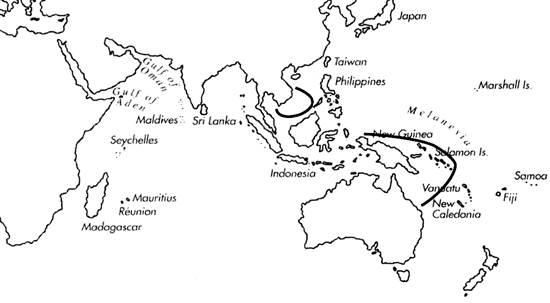Range: Melanesia (Papua New Guinea, Solomon Is.), Queensland, and South China Sea.
Description: Moderately small, light. Last whorl narrowly conoid-cylindrical to narrowly conical; outline slightly convex, less so near base. Shoulder subangulate, with a deep exhalent notch. Spire usually of moderate height, outline nearly straight. Larval shell of about 3 whorls, maximum diameter about 1 mm. First 3-4.5 postnuclear whorls tuberculate. Teleoconch sutural ramps with 1 strong spiral groove in first 3 whorls and 2 increasing to 2-4 grooves in following whorls. Last whorl almost smooth or with punctate shallow spiral grooves separating ribs near base and ribbons above.
| Shell Morphometry | ||
|---|---|---|
| L | 25-31 mm | |
| RW | 0.02-0.04 g/mm | |
| RD | 0.37-0.43 | |
| PMD | 0.81-0.88 | |
| RSH | 0.19-0.24 | |
Ground colour grey to beige. Last whorl with spiral rows of brown squarish dots and rectangular bars on ribbons. Brown markings usually variably fusing into flames; brown colouration occasionally more general, leaving only a few ground-colour flecks. Larval whorls brown (Solomon Is.) or beige (Papua New Guinea, Queensland). Postnuclear sutural ramps with connected brown radial markings. Aperture translucent.
Periostracum thin, translucent.
Dorsum of foot cream, with densely set brown to black dots pre-marginally; anterior part with brown dots medially, a yellow distal edge and a crescent-shaped black blotch behind; posterior median zone white, minutely dotted with black. Sole of foot white. Tentacles grey to black. Siphon white, mottled with black; tip immaculate (Chaberman, pers. comm., 1981). The animals described above had been identified as "C. aculeiformis" by Chaberman, but their shells suggest that they are C. hopwoodi. Chaberman's description agrees with that given by Richards for C. hopwoodi (pers. comm., 1989).
Habitat and Habits: In 6-36 m, in sand or mud (Solomon Is.; Bailey, pers. comm., 1976). In E. New Britain, on coarse volcanic sand, debris and gravel in 18-36 m; it burrows in the sand during the day (Richards, pers. comm., 1989).
Discussion: C. hopwoodi closely resembles C. longurionis in shape. and pattern. This species differs from C. hopwoodi in its larger size (to 46 mm), often higher spire (RSH 0.19-0.30), larger number of tuberculate teleoconch spire whorls (5-8), and in its often more conical and broader last whorl (RD 0.39-0.48; PMD 0.83-0.90). It is possible that the two are conspecific. C. aculeiformis differs in its generally broader last whorl (RD 0.40-0.47), angulate to carinate shoulder, absence of any tuberculate whorls, and different arrangement of the spiral grooves on its postnuclear sutural ramps. For comparison with C. elegans, see the Discussion of that species.

C. hopwoodi range map
This section contains verbatim reproductions of the accounts of 316 species of Conus from the Indo-Pacific region, from Manual of the Living Conidae, by Röckel, Korn and Kohn (1995). They are reproduced with the kind permission of the present publisher, Conchbooks.
All plates and figures referred to in the text are also in Röckel, Korn & Kohn, 1995. Manual of the Living Conidae Vol. 1: Indo-Pacific Region.
The range maps have been modified so that each species account has it own map, rather than one map that showed the ranges of several species in the original work. This was necessary because each species account is on a separate page on the website and not confined to the order of accounts in the book.